|
|
|||||
| home > architetture | |||||
| AVATAR
ARCHITETTURA WITH LANG AND SALVI. elasticity. Manifesto for an ORCHESTRATED
URBANISM |
|||||
| [in italiano] |
 elasticity is a highly elastic spatial and architectural urban infrastructure designed to support flexible living systems responsive to both short and long term demands. elasticity can be seen as an orchestrated urban system in which competing and interrelated city rhythms keep the architectural urban infrastructure in continuous transformation and movement. These movements include: alternating traffic use cycles, advancing and retreating commercial infrastructures, multiple use recreational and leisure activity spaces; short, medium and long term residential living cycles and time-share activities. Play cycles determine the rhythmic patterns for the entire system. |
[01jul2004] | |||
| *The
Site: 3 HOUSING SITE PROPOSALS: 1. CLUSTER LAYOUT; 2. RIBBON LAYOUT; 3. DIFFUSED LAYOUT. ARAMPOSTA has become the experimental locus for the first elasticity, a broad scale proposal for an alternative suburban-peripheral lifestyle in a park environment. The increasingly popular global trend for people to move to the green suburbs from the center core city has by and large been ignored by architects, who see the patterned retro-styled landscaped home divisions a form of “low” architecture rarely worth addressing. Worse, the current forms of “new Urbanism” and catalogue housing are extremely inefficient and wasteful. Houses barely built to last 10 years are made to look monumental and permanent. Decentralized sprawling landscapes are energy inefficient and transportation nightmares. elasticity proposes a MANIFESTO for a new mode of living, providing a series of alternative site options, home options, shopping options, services options and recreational options connectable to an infrastructure network set in a green park landscape. elasticity permits a ground transportation system using standard conveyance vehicles over loosely traced road corridors through the home-garden environment, variable according to the type of plan in use (Cluster Layout; Ribbon Layout; Diffused Layout) and linked to a main transportation spine, the MRR (Main Ramblas Road). The MRR is calibrated according to traffic use, expanding and contracting in width to respond to rush hour traffic, and shopping peaks. The whole cacophony of events together produce a vibrant and dynamic flexible urban condition efficiently timed to the rhythm of today's modern daily life. |
|||||
|
*Occupancy systems: TH (TREE HOUSE) AND RRPH (RECYCLED ROLLING PLASTIC HOUSE) The TH is a variable height re-combinative clustered home unit that is suspended above the park landscape. It can be arranged to house single families or serve as mini-hotels or residential dormitories.  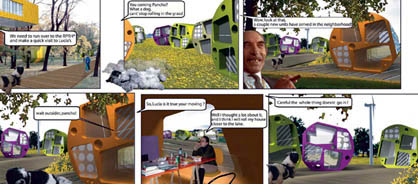 The RRPH is a prefabricated home unit section designed to be assembled in series and roll over. The unit has three sides, and three different living arrangements according to which side is placed at bottom. This unit serves for single users, short term stays and temporary occupancy. 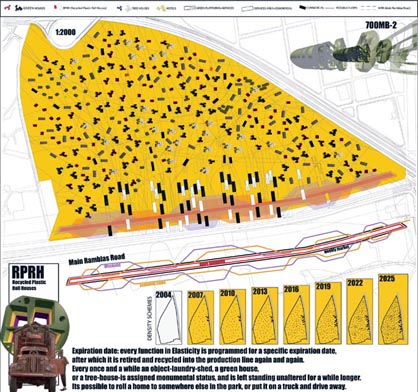 Long-term residents will occupy houses designed to last the life-span of the original inhabitants, between 3 to 12 years (timed to the product life-spans of the selected house materials and calculated on average stays in the local area). When the homes exceed their function and life expectancy they will be dismantled and materials recycled back into the system.  Recent arrivals will have the chance of living in newly constructed homes, thus permitting more customized accommodations, reflecting changes over time in lifestyle, technological improvements and different cultural or ethnic backgrounds. |
|||||
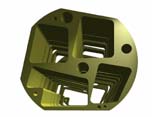   |
   Hotel and hostel structures will add pre-fabricated units or subtract them according to seasonal tourist and visitor demands. Dormitory structures will be removed and stored during the non-academic calendar. Part of the local population will be part time employed according to demands on putting up or dismantling units. Speculation on the growth and shrinkage of the community will finance the local economy. *Shopping: FCC Flexible Commerce Center The FCC is a mobile container structure that moves back and forth across the MRR during the course of the day. Each mobile container structure houses up six commercial retail units inside its volume. |
||||
 In a typical weekday, the MRR (Main Ramblas Road) becomes wider or narrower, depending on user patterns. The MRR, running parallel to the Canal, can be transformed from heavy vehicular traffic to light vehicular traffic to all pedestrian corridor, depending on peak and off peak shopping uses and through traffic demands. This tightening and loosening of the traffic corridor is accomplished by the advancing and retreating of the FCC, the commercial establishments, stores and stalls that mechanically move up to form narrow pedestrian walking areas to increase pedestrian congestion and then recede when shopping traffic hours are minimal to allow for through traffic. 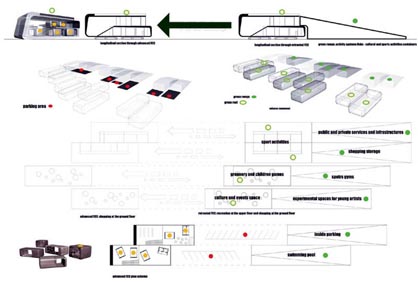 On weekends, large portions of the FCC, commercial parking areas, rooftops and street spaces are turned over to recreation uses, from skateboarding to blading, hockey, basketball to cricket. Gardens set aside for year round use will feature seasonal plantings and offer areas of personal green vegetable gardens. Recreational games and activities can be orchestrated to blend in seamlessly with all the other community activities during the calendar year, and is the critical play element in this composition that makes all the other movements work. *Information Centers: MB Mobile Kiosks. The MBs are to be found dispersed throughout the residential, recreational and commercial park areas, and are primarily designed as information points, providing internet contacts and systems information. *Recreation: elasticity is first and foremost a public park. A network of game and recreation activities is dispersed across the site, connecting residential, commercial and retail areas together. Play therefore sets the ground pattern for the network, pathways, functions, traces across the landscape. 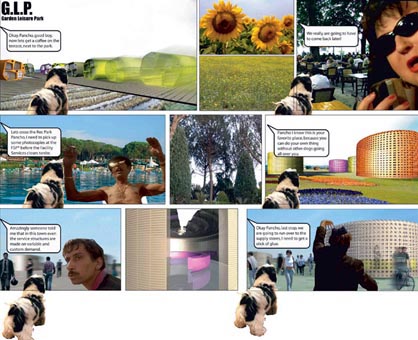 *The Periodic Table: The Periodic Table is a general chart that describes the rhythmic movements of this novel form of orchestrated urbanism. Each of the many functions programmed for the Aramposta site are planned according to different life cycles, to promote customization and individualization and recycling back into the system.  The Periodic Table describes each of the specific functions and their programmed life cycles, expiration dates, variable uses. |
|||||
| AVATAR
ARCHITETTURA WITH LANG AND SALVI. elasticity. Manifesto for an ORCHESTRATED
URBANISM |
|||||
| Project
developed on the occasion of 400.000
habitatges/dwellings international competition promoted by QUADERNS. site: Amposta (Spain) year: 2004 project: Nicola Santini, Pier Paolo Taddei (Avatar architettura) Peter Lang Michele Salvi collaborators: Enrica Longo, Nadia Leccese, Daniela Urro |
|||||
| > AVATAR ARCHITETTURA | |||||
|
Per
candidare progetti laboratorio
|
|||||